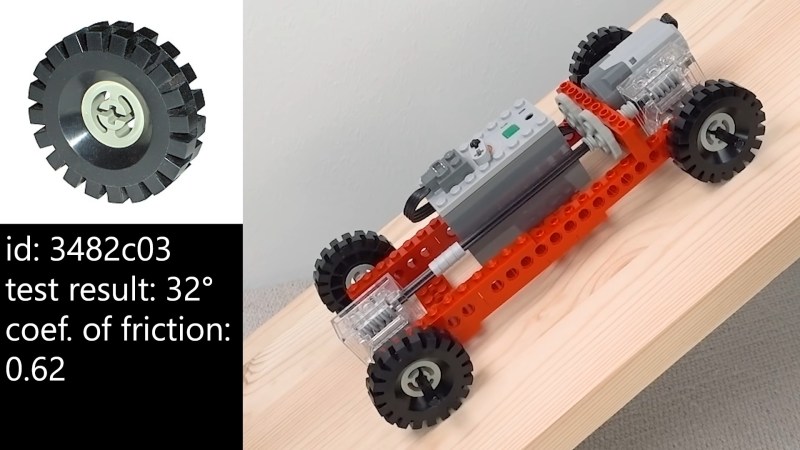For many people, Lego is their first entry into the world of engineering. With the Technic line of building blocks complete with all manner of gears and shafts and wheels, there’s a ton of fun to be had while learning about the basic principles of mechanical things. The [Brick Experiment Channel] takes Lego quite seriously in this context, and has collected data concerning the performance of a variety of Lego wheels and tracks.
The testing setup is simple. A small vehicle is fitted with a particular set of Lego wheels or tracks. Then, it’s placed on an inclined wooden board. The angle of inclination is then increased until the vehicle neither climbs the board nor slips down it. This angle can then be used to calculate the coefficient of friction of the given tyre or track set. [Brick Experiment Channel] filmed this testing and collected data on 33 different wheel and track combinations, publishing it in the description of the Youtube video.
Interestingly, the date of release of the various parts is recorded with the data. This is interesting as one would expect older rubber parts to lose grip with age, however, the release date of the parts obviously does not correspond with the manufacturing date, so the utility of this is somewhat unclear. There’s also some surprising results, with what appear to be soft, flat and smooth rubber wheels performing somewhat worse than those with curved profiles that you’d expect to have less contact patch. Regardless, it’s the best data we’ve ever seen in this field and we think it’s great that it was collected and shared with the broader Lego community. We look forward to seeing more of this in future, as it’s obviously something of great use to builders. We can imagine it would have proved handy when [Brick Experiment Channel] built their obstacle climbing rover. Video after the break.
















Just a guess, but the reason why smaller contact patch could have more friction in this test is that with the force concentrated on a smaller area, the rubber deforms more. It can then reach deeper to the small imperfections in the surface.
On a perfectly flat surface the contact patch size or the vehicle weight wouldn’t affect this measurement, only the coefficient of force would.
There’s a problem with the test methodology. By using a piece of board it’s not perfectly reproducible due to the natural variability of wood. There’s also the issue of friction variability across the surface of the piece of wood. Testing on a uniform synthetic surface would produce better data and other people could replicate the test setup exactly.
Mechanical interlocking and chemical adhesion both fudge the results. You can’t compare a lego wheel from the 70’s with a new wheel that has fresh rubber on it.
what’s “uniform”? industrial materials typically don’t call out values for coefficient of friction. the test setup is fine. you should not expect to be able to compare your results against someone else’s. you should be able to compare your own results against themselves.
This test isn’t even self consistent though. No control for different weights due to differing drivetrains and wheelbases appears to be observed. There is also no control of center of mass, which when higher will put more weight on rear wheels and lift it off the front wheels, meaning grip is more asymmetrical than it is on the shorter vehicles with smaller wheels and lower centers of mass.
Here’s a comparison of the traction of 19 Lego wheels/tracks on five different surfaces by technical-aspects-of-Lego expert Philippe “Philo” Hurbain: https://philohome.com/traction/traction.htm
Additionally, the effects of number of wheels, weight of the vehicle, and rotation speed were briefly investigated.
No video—this testing was done before YouTube—but the page presents the results nicely.
The video is mildly entertaining, but an absolute pain if you need to extract information from it. Search by Lego part number? Forget it, you have to scrub through the whole video looking for it.
Give me a (written) description of the test method and a chart of results. A video is purely for entertainment value.